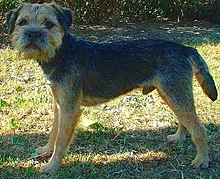Border Terrier
This article needs additional citations for verification. (April 2021) |
| Border Terrier | |||||||||||||||||||||||
|---|---|---|---|---|---|---|---|---|---|---|---|---|---|---|---|---|---|---|---|---|---|---|---|
 Male Border Terrier | |||||||||||||||||||||||
| Origin | United Kingdom | ||||||||||||||||||||||
| |||||||||||||||||||||||
| |||||||||||||||||||||||
| Dog (domestic dog) | |||||||||||||||||||||||
The Border Terrier is a British breed of small, rough-coated terrier. It originates from the area of the Anglo-Scottish border, and shares ancestry with the Dandie Dinmont Terrier and the Bedlington Terrier from the same area.[2] The dogs were traditionally used in fox-hunting, and worked with the in Northumberland.
The breed was officially recognised by The Kennel Club in Great Britain in 1920, and by the American Kennel Club in 1930.[citation needed]
History[]
Originally the Border Terrier was referred to as the Coquetdale Terrier or Redesdale Terrier from the area in which it evolved, but by the late 1800s it was generally known as the Border Terrier, probably because of its long history with the Border Hunt in Northumberland. It shares its ancestry with that of the Bedlington Terrier and the Dandie Dinmont Terrier. It was recognised as a breed by the Kennel Club in 1920, the same year The Border Terrier Club was formed. Their original purpose was to bolt foxes which had gone to ground. They were also used to kill rodents, but they have been used to hunt otters and badgers too.
The first Kennel Club Border Terrier ever registered was The Moss Trooper, a dog sired by Jacob Robson's Chip in 1912 and registered in the Kennel Club's Any Other Variety listing in 1913. The Border Terrier was rejected for formal Kennel Club recognition in 1914, but won its slot in 1920, with the first standard being written by Jacob Robson and John Dodd. Jasper Dodd was made first President of the Club.
In 2006, the Border Terrier ranked 81st in number of registrations by the AKC,[3] while it ranked tenth in the United Kingdom.[4]
In 2008, the Border Terrier ranked eighth in number of registrations by the UK Kennel Club.
Characteristics[]


The Border Terrier was bred to have long enough legs to keep up with the horses and other foxhounds, which travelled with them, and small enough bodies to crawl in the burrows of foxes and chase them out so the hunters had a blank shot. The foxhounds that travelled with them were not small enough to do the Border Terrier's job.[citation needed]
Border Terriers have a broad skull and moderately short muzzle, and strong teeth.[5]The V-shaped ears are on the sides of the head and fall towards the cheeks.[5] Common coat colours are grizzle-and-tan, blue-and-tan, red, or wheaten.[5] Whiskers are few and short.[5] The tail is naturally moderately short, thick at the base and tapering.[5]
Narrow-bodied and well-proportioned, males stand 13 to 16 in (33 to 41 cm) at the shoulder, and weigh 13 to 15.5 lb (5.9 to 7.0 kg); females 11 to 14 in (28 to 36 cm) and 11.5 to 14 pounds (5.2 to 6.4 kg).[5]
The Border Terrier has a double coat consisting of a short, dense, soft undercoat and harsh, wiry weather- and dirt-resistant, close-lying outer coat with no curl or wave.



Health[]
Borders are a generally hardy breed, though there are certain genetic health problems associated with them, including:
- Hip dysplasia
- Perthes disease
- Various heart defects
- Juvenile cataracts
- Progressive retinal atrophy
- Seizures
- Canine epileptoid cramping syndrome (CECS)[6][7]
A UK Kennel Club survey puts their median lifespan at 14 years and listed a maximum age of 22 years, one month.[8]
See also[]
- Dogs portal
- List of dog breeds
References[]
| Wikimedia Commons has media related to Border Terrier. |
- ^ Jump up to: a b Border Terrier. The Kennel Club. Accessed May 2021.
- ^ "History of the Border Terrier". Archived from the original on 23 July 2014. Retrieved 23 July 2014.
- ^ "AKC Dog Registration Statistics". Akc.org. 2 February 2009. Archived from the original on 16 July 2007. Retrieved 20 February 2009.
- ^ "2006 Top 20 Breed Registrations". The Kennel Club. 23 January 2007. Archived from the original on 15 April 2009. Retrieved 20 February 2009.
- ^ Jump up to: a b c d e f "American Kennel Club - Border Terrier". Akc.org. Archived from the original on 19 February 2009. Retrieved 20 February 2009.
- ^ Marilyn A Reed - Small World Web Design. "Canine Epileptoid Cramping Syndrome". Borderterrier-cecs.com. Archived from the original on 28 February 2009. Retrieved 20 February 2009.
- ^ "Canine Epileptoid Cramping Syndrome". Genetic Welfare Problems of Companion Animals. ufaw.org.uk: Universities Federation for Animal Welfare. Archived from the original on 8 March 2015. Retrieved 10 February 2015.
- ^ "Individual Breed Results for Purebred Dog Health Survey". Archived from the original on 4 May 2007. Retrieved 26 June 2012.
- FCI breeds
- Terriers
- Dog breeds originating in Scotland
- Dog breeds originating in England